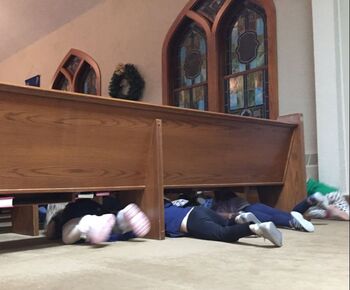First, think outside the box. Try allowing your child to lie on the floor while doing their homework. This position requires less focus and concentration of the balance system while also helping to provide information about where their body is in space. You may find this eliminates half of the battle.
Need to practice spelling words? How about jumping or hopping them out? Write a word on a personal-sized whiteboard and have your child jump up and down while saying each letter (one jump per letter). You could use this same approach with learning math facts. Research shows combining movement while learning increases the speed at which children learn! Finally, consider alternate times of the day to accomplish the work. School days are packed with loads of learning. So, while sitting down right after school may seem to you like the best time to “get it done and over with”, your child’s brain may need to rest first. Some families even wait until the next morning before school to complete assignments.
0 Comments
Welcome back from winter break! We know getting back into the swing of things after the break can be a challenge. For some students the dramatic change in structure from being at home for a week or two and then back to school is difficult. It may appear as if they have forgotten everything you’ve taught in the first trimester of school and you may feel like you are back to square one.
Stay low, push off with your foot, and reach out with your arms. When I see a good gator I'm going to ring a bell.” Or “When you go to the Creep Track today, be sure to look at your hand as you slap the card gently. Say what you see as you slap it and go slowly. Slow is good on the Creep Track.”
You may even want to reteach these activities, just as you did at the beginning of the year. Have them sit down in an area. Go over each activity one at a time. Model for them the correct procedure and then have a student model the procedure. Finally, have everyone do the activity and be sure to give specific and positive feedback as the children do the activities. We know taking the time to refresh, review, and reteach will also help you and your students reinvest in the benefits of the S.M.A.R.T. Program. References: S.M.A.R.T. Pre-K CORE Guide pages 33-34, 40-41, 47-49, and 50-53 S.M.A.R.T. Curriculum Guide pages 36-37, 51-53, 66-68, and 69-71 Sneezing, sniffling, and coughing – sound familiar? Cold and flu season is upon us and the best way to stop the spread of these pesky germs is to wash your hands.
 "It’s too cold to go outside." Most educators dread hearing the announcement regarding indoor recess but One S.M.A.R.T. Teacher, Karla, from Isanti uses her creativity to conquer the cold! When the weather won’t cooperate she brings her students upstairs and lets them Alligator Crawl under the pews. We think this is quite clever for a number of reasons! Alligator Crawling under the pews provides a physical boundary to keep them low, encourages them not to use their elbows, and allows them to get some purposeful stimulation on an otherwise sedentary day. Doing S.M.A.R.T. in a different space also helps keep her course fresh and interesting during the winter. Karla tells us her students at Heavenly Sunshine Preschool really enjoy doing large motor movements, especially in a space they would otherwise not be allowed to crawl around! Post in the comments section the clever ways your students do S.M.A.R.T. activities! |
AuthorSCheryl Smythe Archives
May 2024
|




 RSS Feed
RSS Feed